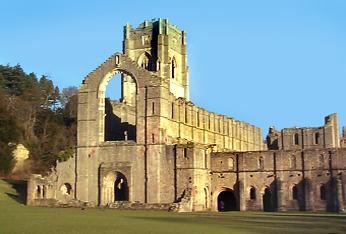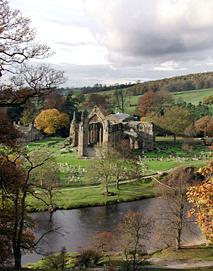|
|
|
‘It is unsurpassed in loveliness among all the ruins of England, and no ruined
abbey surpasses it in the completeness of its survival…It is a superb and
stupendous place’, wrote Arthur Mee. More prosaically, Yorkshire Dales in a Week
describes Fountains Abbey and Studley Royal as ‘unmissable’. 300,000 visitors a
year come to this World Heritage Site; it never seems particularly busy but then
we don’t go on bank holidays.
In 1132 some Benedictine monks at St Mary’s Abbey, York, displeased with the
laxity of that monastery, with the help of Archbishop Thurston emigrated to a
new site in the valley of the little River Skell, to live a more godly and a
simpler life according to Cistercian rule. It was, a chronicle of 1207 recorded,
‘a place remote from the world, uninhabited, set with thorns…fit more, it
seemed, for the dens of wild beasts than for the uses of mankind’. Still, Ripon
was just down the road if they ran out of milk or wanted to send out for a
pizza.
Their first shelter was under yew trees but before long they began to build the
abbey which became the richest in medieval England as a result of selling high
quality wool to merchants from as far away as Venice and Florence. Most of the
present abbey, including Abbot Huby’s perpendicular tower, dates from the 14th
century. Henry VIII, as every school child should know, dissolved the
monasteries in the 16th century in order to liquidate possible opposition to his
nationalisation of the Church in England and to obtain the wealth of the
monastic foundations.
Probably because of its remoteness, it was not ruined to the extent of many
other abbeys and monasteries. The tower is virtually intact, much of the nave
remains and the vaulted undercroft is still covered. The National Trust cares
for it, in both senses of the expression. One can wander freely through the
ruins in the wooded valley and on to Studley Royal.
John and William Aislabie created the gardens of Studley Royal. John was
Chancellor of the Exchequer until his involvement in the South Sea Bubble
scandal. The landscaped winter garden around the lake and cascades is sheltered
by all manner of trees on the valley sides in which are classical temples,
look-out points and a tunnel. Stepping stones cross the lake above the
waterfall. It is particularly pleasant here in late spring when the primroses,
the blossoms and the rhododendrons are flowering.
The park is lined with avenues of limes and beeches among which are red, fallow
and sika wild deer which roam freely as they have done since medieval times. St
Mary's Church has been described as a Victorian masterpiece with a richly
decorated interior and exceptional stained glass.
Nearby Fountains Mill is a monastic water mill and Fountains Hall is an
Elizabethan mansion in which now are holiday apartments. Fountains Abbey
visitors’ centre has quality products and first-rate food including home-made
cakes.
After all the superlatives, Fountains Abbey and Studley Royal is simply a lovely
place to spend a few hours on a fine day. One comes away from it feeling
revitalised and aware of one’s own small place in England’s continuing story.
|
Among other ruined abbeys in Yorkshire are Kirkstall Abbey on the Aire in Leeds, its stone blackened by Leeds’ industrial past, Rievaulx near Helmsley, most impressive in a beautiful location and Jervaulx hidden away near Masham. There is Whitby Abbey high on the cliffs and scene of the Synod in 664 which settled the date on Easter in England. There’s Byland Abbey between Thirsk and Helmsley, Mount Grace Priory near Northallerton, Easby Abbey in Richmond, Roche Abbey east of Rotherham, and Kirkham Priory, an Augustinian foundation set in a valley beside the River Derwent near Malton. And, of course, there’s Bolton Abbey, near Ilkley and Addingham, owned by the Devonshires and loved by generations of the people of the industrial towns and cities of the West Riding. Bolton Abbey |
|


